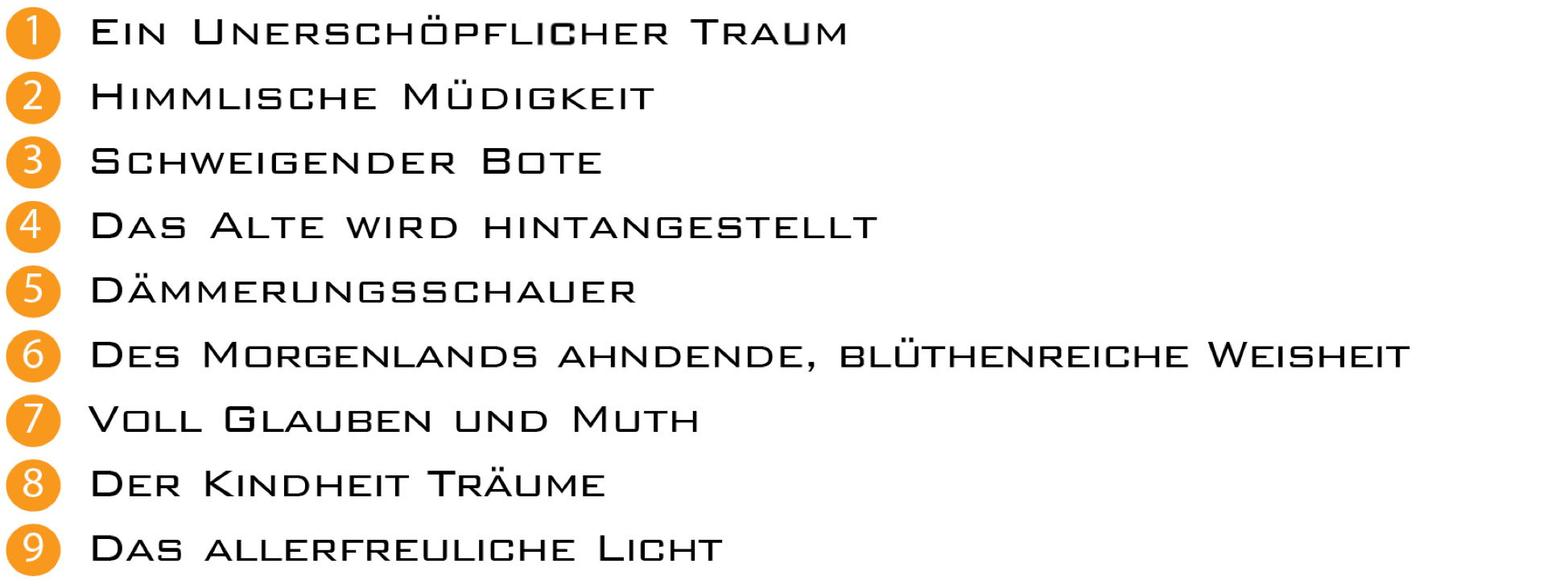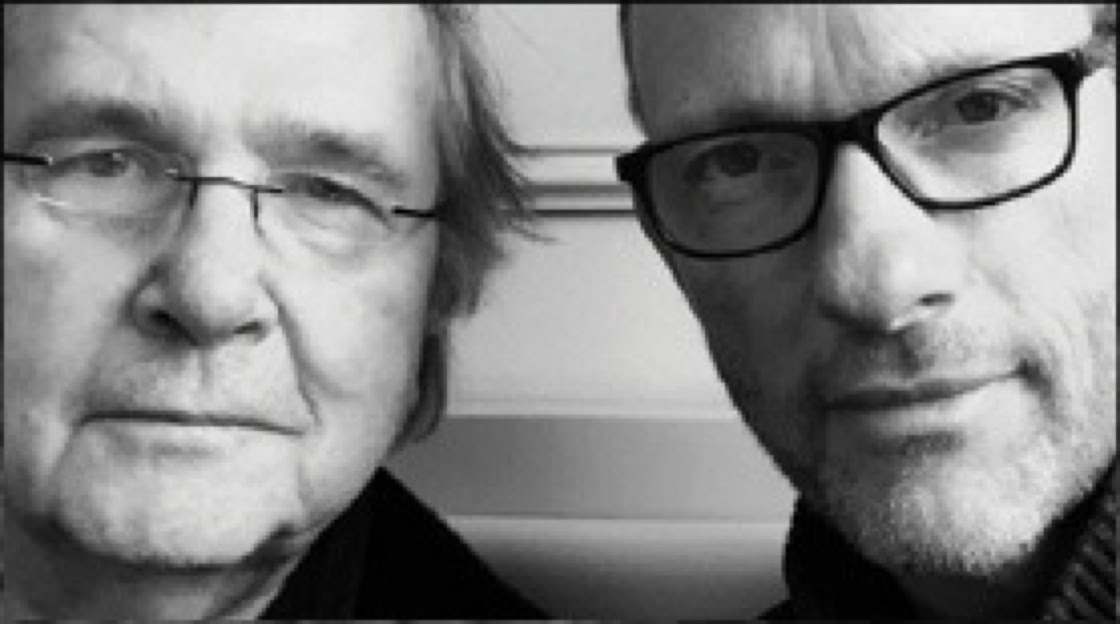


DDD 51:10
All compositions by Theo Jörgensmann and Albrecht Maurer
CATALOG nemu 019
D
Theo Jörgensmann – clarinet
Albrecht Maurer – viola, voice
contact / booking:
watch track Nr. 9 on youtube
Recorded at Thomaskirche Bonn Röttgen, June 2014, mastered by Reinhard Kobialka at Topaz Studio Cologne, cover design and inside photo by Albrecht Maurer.
Produced by Albrecht Maurer and Theo Jörgensmann. Nemu Records, Siebengebirgsallee 12, D–50939 Köln, Germany. Gema + © 2017, all rights re-serv--ed! Made in Germany.
Welche Wollust
Welchen Genuß
Bietet dein Leben
Die aufwögen
Des Todes Entzückungen
Trägt nicht alles
Was uns begeistert
Die Farbe der Nacht
Sie trägt dich mütterlich
Und ihr verdankst du
All deine Herrlichkeit
Du verflögst
In dir selbst
In endlosen Raum
Zergingst du
Wenn sie dich nicht hielte
Dich nicht bände
Daß du warm würdest
Und flammend
Die Welt zeugtest
aus
Novalis
Hymnen an die Nacht

Die Bewegung der Romantiker wendete sich an der Schwelle zum 19. Jahrhundert gegen die Entzauberung der Welt durch die Aufklärung, gegen das kalte Licht der Vernunft und den nüchternen Verstand. In der Überzeugung, dass das Geheimnis der Welt niemals ganz entschlüsselt werden kann, richteten sie ihren Blick auf das Mystische und Phantastische, also auf die Welt hinter den sichtbaren Dingen. Die „Hymnen an die Nacht“ von Novalis, dem romantischen Dichter schlechthin, sind poetischer Ausdruck und Höhepunkt dieser Bewegung. Novalis spricht von einer „Poesie der Nacht und Dämmerung“.
Die Magie, Tiefe und Vielschichtigkeit seiner Sprache inspirierten Theo Jörgensmann und Albrecht Maurer, Extrakte aus den „Hymnen an die Nacht“ für ihre musikalische Reise zu nutzen.
Die beiden Musiker sehen darüberhinaus Parallelen zur Welt der Romantiker: durch die Globalisierung und vor allem die digitale Revolution ist Musik aus allen Erdteilen verfügbar, jeder Winkel ist musikalisch erforscht und ausgeleuchtet. Es gibt kein Geheimnis mehr. Der Westen hat, wieder einmal, alles seiner Formensprache einverleibt und untergeordnet. Was sollte es noch Neues geben?
„Uns geht es beim Spielen immer um Freiheit“, so Albrecht Maurer, „das stilistisch und thematisch zu Markante wollen wir einreißen, es wird zu schnell zu eng und birgt das Erschöpfte und den nahen Stillstand in sich. In gewisser Weise ist unser Spiel eher ein Niederreißen als ein Erfinden”. Die Formel, die der Schriftsteller Klaus Ove Knausgard für die Freiheit aufstellt, gilt auch für Jörgensmann und Maurer: “Freiheit ist gleich Zerstörung plus Bewegung”. Das ist ihr Credo und auch wenn es kämpferisch klingt, so ist das Ergebnis auf erstaunliche Weise voller innerer Ruhe und Homogenität. Die Form entsteht durch das gemeinsame Kreieren im Moment des Spiels und zwar nicht durch Konkurrenz, sondern durch: Freundschaft. Das wechselseitige Formen des Klanges, den anderen gut aussehen und führen zu lassen oder die Führung selbst zu übernehmen, das Vertrauen auf Aktion und Reaktion, den gemeinsam entwickelten Geschmack, die gemeinsamen Spiel–Erfahrungen: “wie viel Markantes oder Thematisches oder wie viel von einem bestimmten Stil können wir gewähren, wann beginnt die gestalterische Lust des Zerstörens – wie denkt und fühlt der jeweils andere”, so Theo Jörgensmann.
Eine leere, einsame und stille Kirche in Bonn-Röttgen war der ideale Aufnahmeort für ihre Reise in die Nacht. Entstanden sind neun Teile, die sich aufeinander beziehen: das Verklungene ist im Neuen präsent, es wirkt weiter und so hat dieses Album eine homogene innere Entwicklung, eine ästhetische Geschlossenheit, eine über jeden Teil hinaus wirkende übergeordnete Form.
Das Zusammentreffen zweier gleichstarker, selbstbewusster Stimmen bewirkt, dass ihre Musik oft bi-metrisch, bi-lingual ist. Ihre unterschiedlichen Erfahrungen verschmelzen zu einer neuen Freiheit, allerdings nicht zu einem Crossover, sondern zu einem Flug ins Grenzenlose. Diese Musik möchte nichts, kein Territorium besetzen und auch keinen Markt erobern. Sie ist ein Wunderland an Wandlungen auf engstem Raum. Wenn beispielsweise im langsamen Tempo die Kopfstimme von Albrecht Maurer mit dem intimen Klarinettenton von Theo Jörgensmann verschmilzt, dann ist zu spüren, dass die gemeinsame Ästhetik in der äußersten Präsenz liegt. In jedem gefundenen Klang steckt ein neuer Aufbruch, auch wenn dieser nicht vollzogen wird. In der Gegenwartsintensität liegt die poetische Kraft. Das gegenseitigen Zuhören und dann das Eintauchen in einen Dialog spinnt die Musik, die manchmal nur an einem seidenen Faden zu hängen scheint, auf magische Weise weiter. Entscheidungen, in welche Richtung es gehen soll, werden in Bruchteilen einer Sekunde getroffen. Übrig bleibt oft nur die feinstoffliche Energie einer homöopathischen Essenz. Und so wirkt diese Musik entrückt, weit entfernt von Patternmusik und von kopflastiger Konstruktion. Es ist pure Musik, gestaltet aus den vielfältigen musikalischen Erfahrungen eines Klarinettisten und eines Bratschers.
Beate Bartlewski, Köln, Januar 2017
E
At the threshold of the 19th century the romantic movement turned against the reconnaissance’s demystification of the world, against the cold light of reason and the prosaic mind. Convinced that the secrets of this world could never be decoded completely, romantics concentrated on mysticism and speculative fiction, on the world hidden behind what is visible. The “Hymns to the Night” by Novalis, who is clearly a romantic poet, are the poetic expression and the climax of this movement. Novalis speaks of “a poetry of the night and the dusk.”
The magic, depth, and the complexity of Novalis’ writings inspired Theo Jörgensmann and Albrecht Maurer to use extracts from “Hymns to the Night” as a map for their musical journey.
Additionally, both musicians see a parallel to the romantic period in today’s musical revolution; globalization and, even more, the digital revolution has made music from all parts of the world readily available. Every corner is musically explored and illuminated. There are no more secrets. Once again, Western culture has assimilated and subordinated everything into its form language. What´s next? What will be invented?
“Our music is about freedom,” Jörgensmann says. “Everything that is too concrete or distinctive in terms of style or musical material has to break down. It feels pokey and has a potential tiredness and stagnation inside. In a certain way our music is more about dismantle than about coming up with something.” The writer Klaus Ove Knausgard established a formula for freedom that also applies to Jörgensmann and Maurer: “Freedom is destruction plus motion.” This is their credo and even if it appears militant, the result is amazingly full of inner calmness and homogeneity. The musical form develops from moments of playing that happen not by competition but by friendship. To mutually modulate the sound, to support the other, to let lead or to take over the leadership, to trust in action and reaction, to trust the development of a common taste, the common experiences of playing. “How much is distinctive or thematic? How much of a certain style can we allow? When does the creative lust to destruct start? How does the other think or feel?” Jörgensmann says.
An empty, lonely, and quiet church in Bonn-Röttgen was the ideal recording place for the duo’s journey into the night. The result is nine sections that refer to each other. The part that has just faded away is still sensed; it influences the present. And so this album has an inner development, an aesthetic coherence a superior form that ties all parts together.
The coincidence of two equipollent, confident “voices” results in music that is often bi-metric and bi-lingual. The musicians’ different experiences meld into a new freedom, certainly not into a kind of crossover, but into an unlimited journey. This music doesn´t want anything. It doesn´t want to occupy a musical place (territory) and it doesn´t want to capture the market. This music is a wonderland of conversion in the smallest spaces. For instance, in a section that is in a slow tempo, the lead voice of Albrecht Maurer merges completely with the intimate clarinet tone of Theo Jörgensmann. You can feel a common aesthetic that is based on being in the moment. Each just-discovered sound contains a new path to something else, even if the musicians don´t always follow that potential idea. The intensity of the moment is their poetic power. They listen to each other and then delve into dialogs, spinning music that sometimes hangs by a thread in a magical way. Decisions as to which direction the music should go are made in fraction of a second. Sometimes all that that remains is the subtle energy of a homeopathic essence. And in this sense the music appears abstracted, far away from pattern music and far away from overly intellectual construction. It is pure music, created with diverse musical experiences of a clarinetist and a violist.
Beate Bartlewski, Cologne, Januar 2017